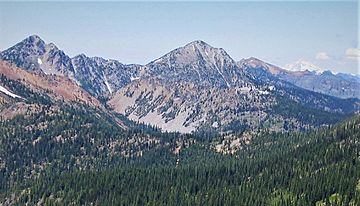Harding Mountain facts for kids
Quick facts for kids Harding Mountain |
|
|---|---|

Harding Mountain centered, south aspect
{Solomon Mountain to left) |
|
| Highest point | |
| Elevation | 7,173 ft (2,186 m) |
| Prominence | 1,253 ft (382 m) |
| Isolation | 3.0 mi (4.8 km) |
| Parent peak | Ingalls Peak (7,662 ft) |
| Geography | |
| Location | Chelan County Washington, U.S. |
| Parent range | Wenatchee Mountains Cascade Range |
| Topo map | USGS Jack Ridge |
| Type of rock | granodiorite |
| Climbing | |
| Easiest route | class 2 scrambling Southeast slope |
Harding Mountain is a tall mountain in Washington state. It stands about 7,173 feet (2,186 meters) high. You can find it in Chelan County. It's the seventh-highest peak in the northern Wenatchee Mountains.
This mountain is part of the beautiful Alpine Lakes Wilderness. It's located about 5.35 miles (8.6 km) northwest of Mount Stuart. It's also 4.1 miles (6.6 km) west of Eightmile Mountain. The land around Harding Mountain is managed by the Wenatchee National Forest.
Water from the mountain flows into Icicle Creek. This creek then joins the Wenatchee River. Harding Mountain was named after Warren G. Harding, who was a President of the United States. Albert Hale Sylvester gave the mountain its name.
Weather Around Harding Mountain
The area around Harding Mountain is a bit drier than places to its west. This is because it lies east of the Cascade Range. Summers here can be warm, and sometimes you might see thunderstorms.
Most weather systems come from the Pacific Ocean. They travel east towards the Cascade Range. When these weather systems reach the tall Cascade Mountains, they are forced to rise. This process is called Orographic lift. As the air rises, it cools down and drops its moisture. This moisture falls as rain or snow on the western side of the Cascades.
Because of this, the eastern slopes of the Cascades get less rain and snow. In winter, it's often cloudy. But in summer, high-pressure systems over the Pacific Ocean usually bring clear skies.
How Harding Mountain Was Formed
The Alpine Lakes Wilderness has very rugged land. You'll see jagged peaks, deep valleys carved by glaciers, and granite rock walls. There are also over 700 mountain lakes in this area.
The different types of land and big changes in height were created by geological events. These events happened millions of years ago. They led to the different climates you see across the Cascade Range.
The Cascade Mountains started forming millions of years ago. This was during a time called the late Eocene Epoch. The North American Plate was slowly moving over the Pacific Plate. This movement caused volcanoes to erupt many times.
Also, small pieces of the Earth's crust, called terranes, came together. These pieces formed the North Cascades about 50 million years ago. Harding Mountain itself is part of a large body of rock called the Mount Stuart batholith.
About two million years ago, during the Pleistocene period, glaciers played a big role. These huge ice sheets moved forward and backward many times. As they moved, they scraped and shaped the land. They left behind piles of rock and debris.
The last glaciers in the Alpine Lakes area started melting and retreating about 14,000 years ago. By 10,000 years ago, they had moved north of the Canada–US border. The river valleys in this area have a U-shape. This shape was created by the glaciers.
The tall peaks and deep valleys of the Alpine Lakes Wilderness were formed by a mix of things. These include the land being pushed up (orogeny), cracks in the Earth's crust (faulting), and the powerful work of glaciers.



